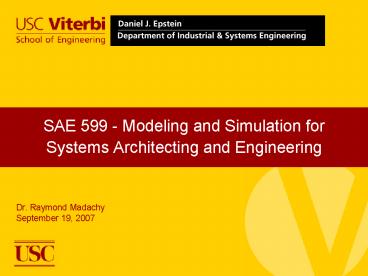SAE 599 Modeling and Simulation for Systems Architecting and Engineering - PowerPoint PPT Presentation
1 / 14
Title:
SAE 599 Modeling and Simulation for Systems Architecting and Engineering
Description:
Simulate the process and observe the accumulation of cars on the freeway. ... It mirrors the arrival rate with a fixed delay time. Device Failure ... – PowerPoint PPT presentation
Number of Views:56
Avg rating:3.0/5.0
Title: SAE 599 Modeling and Simulation for Systems Architecting and Engineering
1
SAE 599 - Modeling and Simulation for Systems
Architecting and Engineering
- Dr. Raymond Madachy
- September 19, 2007
2
Outline
- Course Project Status
- Simulation Tools Revisited
- Demonstrations of Reference Applications with
Continuous Systems Modeling - Homework
3
Course Project Status
- Already chosen
- Jared Fortune EZSIM II architecting and
acceptance testing (EZSIM) - Harry Johnson simulation of sustaining
engineering for the International Space Station
integration processes (Simulink) - Jared Smith - Resource adaptability model for
disasters and terrorist attacks - Possible
- Ben Haas - Carbon emissions model for China to LA
cargo transport - Mentored projects still available
- Motor sports simulation (Settles)
- Limits to change on large SOS projects (Boehm,
Lane) - Front-end GUI for web-based simulation tool
(Madachy) - Major exercises from Software Process Dynamics
(Madachy)
4
Simulation Tool Reviews
- Over 250 tools reviewed against more than 50
attributes - Recommendations
- EZSIM for discrete event modeling
- Continuous systems modeling
- Ithink/Stella (100 from http//iseesystems.com)
- isee player allows running and viewing of
Ithink/Stella models (http//www.iseesystems.com/s
oftwares/player/iseeplayer.aspx) - Can use for class demonstration models
- Vensim Personal Learning Edition (free from
http//www.vensim.com/venple.html) - Agent-based modeling
- NetLogo (http//ccl.northwestern.edu/netlogo/docs/
) - Others per agreement for course projects (Extend,
Simula) - Question Access other students tool reviews?
Objections?
5
Simulation Tools Redux
- General purpose, event-oriented languages
- User constructs event logic and changes to system
state - Includes standard discrete-event modules (event
calendar, statistics, output, etc.) - Low level languages, flexible, but hard to learn
- Examples
- GASP
- SIMSCRIPT
- MODSIM
- General purpose, process-oriented languages
- Contain modules for common processes, with
varying degrees of implementation in different
tools - Entity flow diagram often used to construct
model, and manually or automatically translated
into source statements - Examples
- EZSIM
- SLAM
- GPSS
- SIMAN
- SIMNET
6
Simulation Tools Redux (cont.)
- Continuous system simulation tools implement
rate/level concepts - User manually constructs models or uses a GUI
- Examples
- Ithink
- Vensim
- Powersim
- Forio
- Special purpose simulation environments
- Domain specific process-oriented tools (e.g.
manufacturing, communications, traffic) - High level model construction with icons and
menus - Examples
- SIMFACTORY, WITNESS for factory simulation
- COMNET for communications networks
7
Simulation Tools Redux (cont.)
- Tool selection
- Advantages of traditional computer programming
languages - Flexibility and control, existing compilers, no
training for simulation-specific language,
efficiency, portability - Advantages of general purpose simulation
languages vs. traditional languages - Leverage of high-level commands and modeling
framework, faster development, more
understandable due to modularity - Advantages of special purpose simulation tools
vs. general purpose simulation languages - Simpler to learn for narrower domain, use of
icons and menus, use of domain-specific
terminology - Other considerations
- Price, documentation, training, support and
maintenance, computer platform, user familiarity
8
Demonstration Problems
- The arrival process of cars on a freeway is
exponentially distributed with a mean of 3
minutes. The time to departure from the freeway
is normally distributed with a mean of 15 minutes
and standard deviation of 2 minutes. Simulate the
process and observe the accumulation of cars on
the freeway. - Customers arrive uniformly between 10 and 20
minutes, and the service time is distributed
uniformly between 8 and 15 minutes. Simulate the
system for 500 arriving entities or 10,000
minutes of operation, whichever happens first. - A device has two components that operate in
parallel. It fails if both components fail, and
the probability of each component failing after
one hour is 0.5. Simulate the system operation
to find the time of device failure.
9
Freeway with Constant Rates
- Rates 1 / interarrival times
- Minutes converted to hours
10
Freeway with Stochastic Rates
- Departure rate is not per specification. It
mirrors the arrival rate with a fixed delay time.
11
Device Failure
- The simulation time step DT must be set to one
hour for random failure variables - Random functions and probability distributions
sampled each DT in simulation
12
Demonstrations
13
Homework
- Compare and contrast the freeway application
models using discrete event and continuous
systems simulation - Advantages and disadvantages for this type of
application - Does either method seem better suited?
- Extra credit specify and/or implement a
stochastic departure time in the continuous model - Use EZSIM or another discrete event modeling
tool - There are two roads that join into one highway.
Due to the risk of collision, there is a traffic
light that controls the highway entry. The
interrarrival time on one of the roads is
exponentially distributed with a mean of 4
seconds while the other is 6 seconds. The light
for the road with heavier traffic remains green
for 40 seconds and 30 seconds for the other road.
Observe the queue buildup on both roads.
14
Homework (cont.)
- Use EZSIM or another discrete event modeling
tool - At an air terminal, cargo planes with capacities
of either 50 or 70 cargo units arrive at the rate
of one every 60 minutes. Each plane waits until
it is loaded to capacity, then it takes off.
Fifty-five percent of the arriving planes have a
50-unit capacity. Cargo arrives in batches of
10-unit loads with an exponential interrarrival
time with a mean of 9 minutes. Modeling the unit
loads as resources, run the simulation model of
this system for 100 arriving planes to determine
the average waiting time of each plane before
takeoff.































